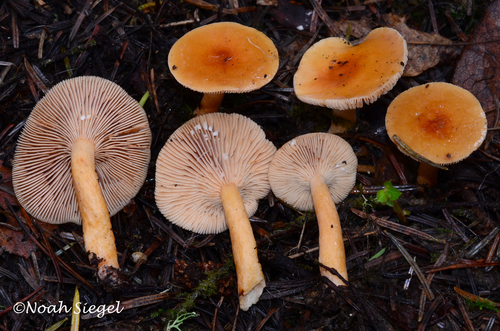Lactarius luculentus laetus
Summary 2
Lactarius luculentus var. laetus is a species that is both exciting and disappointing to find - the bright coloration, beautiful gills, and interesting property of releasing a milky white latex when damaged make it an interesting and exciting mushroom to study. However, foragers who think they've found the famous and nearly identical Lactarius rufus (Candy Cap) will be disappointed by the bitter and acidic flavor of this common Arizona milk cap. It is a mycorrhizal species associated with conifers and is very common above 7,000ft - Bear Wallow Spring in the Santa Catalina Mountains saw thousands of Lactarius luculentus var. laetus growing throughout the area during the fall of 2022.
Basic Identificiation 2
Pileus/Cap: 2-6cm wide, convex with a slight central bump, becoming flat, sometimes with a shallow depression; orange to pale orange.
Lamellae/Gills: Attached to the stem, running down the stem a short distance (decurrent); whitish to orange to pinkish; closely spaced; sometimes staining and orange-brown and releasing a white milk when damaged (may be a very small amount depending on how dry the mushroom is).
Stipe: 2-6cm long and less than 1cm thick, equal or slightly club shaped; colored like the cap; smooth; dry or somewhat moist.
Flesh: Whitish to orangish.
Spores: White.
Habitat/Ecology: Mycorrhizal with conifers at high elevations.
Odor/Taste: Taste mild, bitter, and slightly acrid - but not strongly acrid.
Chemical Stain: KOH olive on cap surface
Similar Taxa 2
Lactarius deterrimus
Laccaria trichodermaphora
Advanced Identification 2
Pileus 3-6 cm broad, broadly convex to plane or the disc with a papilla, disc broadly depressed in age, surface glabrous, opaque when moist, slightly viscid when wet but soon dry, color evenly brilliant orange or margin a little paler, azonate, color duller in age, rarely with watery spots. Context thin but firm, pallid to pale yellow. Latex milk-white, copious, unchanging, staining gills brownish slowly (see Smith 17471), taste mild slowly becoming bitter.
Lamellae "light vinaceous-cinnamon" (pale reddish clay color), narrow (2.5-3 mm), crowded, + 4 tiers of lamellulae, unchanging or in some collections slowly stained brownish. Stipe 4-5 cm long, 5-7 mm thick near apex, equal or a bit enlarged below, hollow, remarkably firm at first but soon fragile, surface smooth, glabrous, colored as in the lamellae or pileus.
Spore deposit not obtained [Editor comment: Spores deposit is white]. Spores 8-10 x 7-8.5 μm, broadly ellipsoid; plage hyaline in Melzer's, the boundaries indefinite; ornamentation of a few prominent bands with Y-branching but no reticulum formed, isolated warts and short ridges present, prominences about 0.4-0.7 μm high.
Basidia 4-spored, 8-12 μm broad, many with refractive content as revived in KOH (more so than in the lactifers). Pleurocystidia: macrocystidia prominently projecting, 56-90 x 9-14 μm, fusoid-ventricose and pointed to sharply fusoid, content not highly refractive in KOH; pseudocystidia not seen. Cheilocystidia basidiole-like to fusoid-ventricose with obtuse apex (none seen resembling macrocystidia). Gill trama lacking distinct rosettes but sphaerocysts present; lactifers inconspicuous in KOH. Pileus trama heteromerous, lactifers inconspicuous. Pileus cuticle a well-developed to a shortened, lax trichoderm showing slime in KOH and in Melzer's, the layer originating from a basal hyphal layer in which some of the cells are inflated but these not forming a distinct layer and not evident in many sections.
Transcribed from: Hesler, L.R. & Smith, A.H. (1979). North American Species of Lactarius. University of Michigan Press: Ann Arbor, MI. 841 p.
References 2
- Hesler, L.R. & Smith, A.H. (1979). North American Species of Lactarius. University of Michigan Press: Ann Arbor, MI. 841 p.
- Kuo, M. (2011, March). Lactarius luculentus var. laetus. Retrieved from the MushroomExpert.Com Web site: http://www.mushroomexpert.com/lactarius_luculentus_laetus.html
Sources and Credits
- (c) noah_siegel, some rights reserved (CC BY-NC-SA), uploaded by noah_siegel
- (c) Spencer Wimmer, some rights reserved (CC BY-NC-SA)





